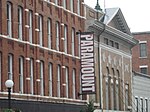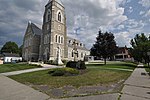Rutland (city), Vermont
Cities in Rutland County, VermontCities in VermontCommons category link is locally definedCounty seats in VermontMicropolitan areas of Vermont ... and 3 more
Rutland, VermontRutland (city), VermontUse mdy dates from January 2017

Rutland is the only city in and the seat of the county of the same name in Vermont, United States. As of the 2020 census, the city had a total population of 15,807. It is located approximately 65 miles (105 km) north of the Massachusetts state line, 35 miles (56 km) west of New Hampshire state line, and 20 miles (32 km) east of the New York state line. Rutland is the third largest city in the state of Vermont after Burlington and South Burlington. Rutland City is completely surrounded by Rutland Town, which is a separate municipality. The downtown area of the city is listed as a historic district on the National Register of Historic Places.
Excerpt from the Wikipedia article Rutland (city), Vermont (License: CC BY-SA 3.0, Authors, Images).Rutland (city), Vermont
Cottage Street, Rutland City
Geographical coordinates (GPS) Address Nearby Places Show on map
Geographical coordinates (GPS)
| Latitude | Longitude |
|---|---|
| N 43.608888888889 ° | E -72.979722222222 ° |
Address
Cottage Street
05701 Rutland City
Vermont, United States
Open on Google Maps








